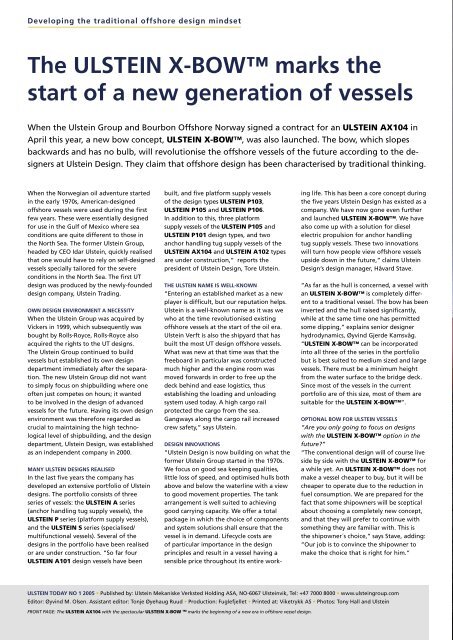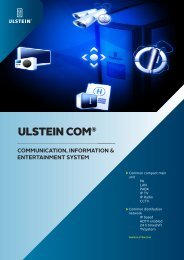Ulstein Today no 1, 2005 - Ulstein Group
Ulstein Today no 1, 2005 - Ulstein Group
Ulstein Today no 1, 2005 - Ulstein Group
Create successful ePaper yourself
Turn your PDF publications into a flip-book with our unique Google optimized e-Paper software.
Developing the traditional offshore design mindset<br />
The ULSTEIN X-BOW marks the<br />
start of a new generation of vessels<br />
When the <strong>Ulstein</strong> <strong>Group</strong> and Bourbon Offshore Norway signed a contract for an ULSTEIN AX104 in<br />
April this year, a new bow concept, ULSTEIN X-BOW, was also launched. The bow, which slopes<br />
backwards and has <strong>no</strong> bulb, will revolutionise the offshore vessels of the future according to the de-<br />
signers at <strong>Ulstein</strong> Design. They claim that offshore design has been characterised by traditional thinking.<br />
When the Norwegian oil adventure started<br />
in the early 1970s, American-designed<br />
offshore vessels were used during the first<br />
few years. These were essentially designed<br />
for use in the Gulf of Mexico where sea<br />
conditions are quite different to those in<br />
the North Sea. The former <strong>Ulstein</strong> <strong>Group</strong>,<br />
headed by CEO Idar <strong>Ulstein</strong>, quickly realised<br />
that one would have to rely on self-designed<br />
vessels specially tailored for the severe<br />
conditions in the North Sea. The first UT<br />
design was produced by the newly-founded<br />
design company, <strong>Ulstein</strong> Trading.<br />
OWN DESIGN ENVIRONMENT A NECESSITY<br />
When the <strong>Ulstein</strong> <strong>Group</strong> was acquired by<br />
Vickers in 1999, which subsequently was<br />
bought by Rolls-Royce, Rolls-Royce also<br />
acquired the rights to the UT designs.<br />
The <strong>Ulstein</strong> <strong>Group</strong> continued to build<br />
vessels but established its own design<br />
department immediately after the separation.<br />
The new <strong>Ulstein</strong> <strong>Group</strong> did <strong>no</strong>t want<br />
to simply focus on shipbuilding where one<br />
often just competes on hours; it wanted<br />
to be involved in the design of advanced<br />
vessels for the future. Having its own design<br />
environment was therefore regarded as<br />
crucial to maintaining the high tech<strong>no</strong>logical<br />
level of shipbuilding, and the design<br />
department, <strong>Ulstein</strong> Design, was established<br />
as an independent company in 2000.<br />
MANY ULSTEIN DESIGNS REALISED<br />
In the last five years the company has<br />
developed an extensive portfolio of <strong>Ulstein</strong><br />
designs. The portfolio consists of three<br />
series of vessels: the ULSTEIN A series<br />
(anchor handling tug supply vessels), the<br />
ULSTEIN P series (platform supply vessels),<br />
and the ULSTEIN S series (specialised/<br />
multifunctional vessels). Several of the<br />
designs in the portfolio have been realised<br />
or are under construction. “So far four<br />
ULSTEIN A101 design vessels have been<br />
built, and five platform supply vessels<br />
of the design types ULSTEIN P103,<br />
ULSTEIN P105 and ULSTEIN P106.<br />
In addition to this, three platform<br />
supply vessels of the ULSTEIN P105 and<br />
ULSTEIN P101 design types, and two<br />
anchor handling tug supply vessels of the<br />
ULSTEIN AX104 and ULSTEIN A102 types<br />
are under construction,” reports the<br />
president of <strong>Ulstein</strong> Design, Tore <strong>Ulstein</strong>.<br />
THE ULSTEIN NAME IS WELL-KNOWN<br />
“Entering an established market as a new<br />
player is difficult, but our reputation helps.<br />
<strong>Ulstein</strong> is a well-k<strong>no</strong>wn name as it was we<br />
who at the time revolutionised existing<br />
offshore vessels at the start of the oil era.<br />
<strong>Ulstein</strong> Verft is also the shipyard that has<br />
built the most UT design offshore vessels.<br />
What was new at that time was that the<br />
freeboard in particular was constructed<br />
much higher and the engine room was<br />
moved forwards in order to free up the<br />
deck behind and ease logistics, thus<br />
establishing the loading and unloading<br />
system used today. A high cargo rail<br />
protected the cargo from the sea.<br />
Gangways along the cargo rail increased<br />
crew safety,” says <strong>Ulstein</strong>.<br />
DESIGN INNOVATIONS<br />
“<strong>Ulstein</strong> Design is <strong>no</strong>w building on what the<br />
former <strong>Ulstein</strong> <strong>Group</strong> started in the 1970s.<br />
We focus on good sea keeping qualities,<br />
little loss of speed, and optimised hulls both<br />
above and below the waterline with a view<br />
to good movement properties. The tank<br />
arrangement is well suited to achieving<br />
good carrying capacity. We offer a total<br />
package in which the choice of components<br />
and system solutions shall ensure that the<br />
vessel is in demand. Lifecycle costs are<br />
of particular importance in the design<br />
principles and result in a vessel having a<br />
sensible price throughout its entire work-<br />
ing life. This has been a core concept during<br />
the five years <strong>Ulstein</strong> Design has existed as a<br />
company. We have <strong>no</strong>w gone even further<br />
and launched ULSTEIN X-BOW. We have<br />
also come up with a solution for diesel<br />
electric propulsion for anchor handling<br />
tug supply vessels. These two in<strong>no</strong>vations<br />
will turn how people view offshore vessels<br />
upside down in the future,” claims <strong>Ulstein</strong><br />
Design’s design manager, Håvard Stave.<br />
“As far as the hull is concerned, a vessel with<br />
an ULSTEIN X-BOW is completely different<br />
to a traditional vessel. The bow has been<br />
inverted and the hull raised significantly,<br />
while at the same time one has permitted<br />
some dipping,” explains senior designer<br />
hydrodynamics, Øyvind Gjerde Kamsvåg.<br />
“ULSTEIN X-BOW can be incorporated<br />
into all three of the series in the portfolio<br />
but is best suited to medium sized and large<br />
vessels. There must be a minimum height<br />
from the water surface to the bridge deck.<br />
Since most of the vessels in the current<br />
portfolio are of this size, most of them are<br />
suitable for the ULSTEIN X-BOW”.<br />
OPTIONAL BOW FOR ULSTEIN VESSELS<br />
“Are you only going to focus on designs<br />
with the ULSTEIN X-BOW option in the<br />
future?”<br />
“The conventional design will of course live<br />
side by side with the ULSTEIN X-BOW for<br />
a while yet. An ULSTEIN X-BOW does <strong>no</strong>t<br />
make a vessel cheaper to buy, but it will be<br />
cheaper to operate due to the reduction in<br />
fuel consumption. We are prepared for the<br />
fact that some shipowners will be sceptical<br />
about choosing a completely new concept,<br />
and that they will prefer to continue with<br />
something they are familiar with. This is<br />
the shipowner´s choice,” says Stave, adding:<br />
“Our job is to convince the shipowner to<br />
make the choice that is right for him.”<br />
ULSTEIN TODAY NO 1 <strong>2005</strong> • Published by: <strong>Ulstein</strong> Mekaniske Verksted Holding ASA, NO-6067 <strong>Ulstein</strong>vik, Tel: +47 7000 8000 • www.ulsteingroup.com<br />
Editor: Øyvind M. Olsen. Assistant editor: Tonje Øyehaug Ruud • Production: Fuglefjellet • Printed at: Viketrykk AS • Photos: Tony Hall and <strong>Ulstein</strong><br />
FRONT PAGE: The ULSTEIN AX104 with the spectacular ULSTEIN X-BOW TM marks the beginning of a new era in offshore vessel design.<br />
The new ULSTEIN X-BOW<br />
concept turns the traditional<br />
offshore design upside down




